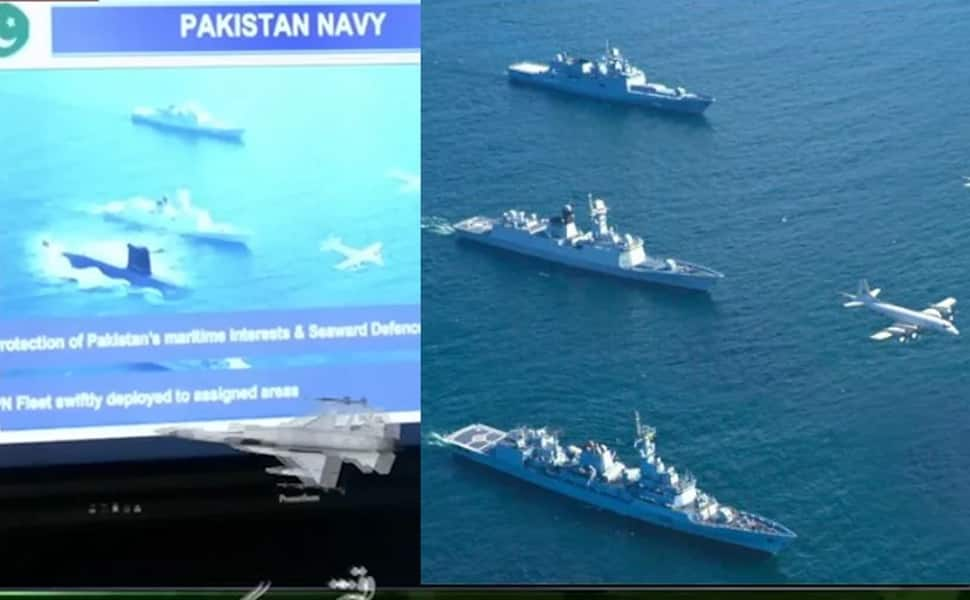India recently inducted new ships into its navy. While it got INS Tamal – F 71, the latest Stealth Frigate, on July 1, it inducted the stealth frigate Udaygiri and INS Arnala, the first of 16 Anti-Submarine Warfare Shallow Water Craft (ASW-SWC) vessels in the last two weeks. While the Indian Navy is strengthening its fleet, its arch rival Pakistan is staring at an ageing fleet, maintenance woes and low morale, especially after Operation Sindoor when India forced the Pakistani navy to remain at their bases.
Indian Navy In Operation Sindoor
The Indian Navy was absolutely vital in establishing maritime dominance during Operation SINDOOR. They operated as a seamless, networked force, deploying their formidable Carrier Battle Group (CBG). This group, armed with MiG-29K fighter jets and advanced airborne early warning helicopters, ensured constant vigilance and immediate threat identification across the entire maritime area.
The CBG maintained a powerful air defence shield, successfully preventing any hostile aircraft from penetrating, especially those originating from the Makran coast. The Navy’s strong presence acted as a significant deterrent, effectively pinning down Pakistani air elements along their western seaboard and denying them any room to operate.
Indian naval pilots executed round-the-clock sorties, showcasing India’s preparedness and strategic reach in the region. The Navy’s success in establishing unchallenged control over the seas also served as a powerful validation of its anti-missile and anti-aircraft defence capabilities even in a challenging threat environment. The Indian Navy’s power during Operation Sindoor made the Pakistani Navy ineffective while destroying their morale.
Morphed Photo Of Pride
Notably, post Operation Sindoor, the Indian Navy released several videos showcasing its operational readiness to protect India. The Indian Navy video also showcased its ship firing missiles to test its capabilities. To counter India, Pakistan came out with a presser but ended up showing a morphed photo to claim it as their own.

Pakistan’s Fragile Fleet
According to reports, the Pakistani Navy is staring at an unprecedented crisis not only due to an ageing fleet but also due to limited weapons. While India is boosting its naval capabilities, Pakistan has limited numbers of submarines, while its ships are facing high-maintenance costs due to ageing.
The Pakistan Navy is facing a deep crisis in the aftermath of Operation Sindoor, with an ageing fleet, low morale, and limited submarines, reflective of the growing strain amid India’s rising naval edge. Such is the situation that the Pakistani navy’s principal surface combatants remain pier-side at Karachi naval base, reported News18.
The report highlighted that Pakistan only has two operational submarines, while the rest are not ready for operation. The new recruits have been stationed at maintenance and repair facilities instead of spending time at sea and participating in naval exercises.
Many of Pakistan’s main warships, specifically the Type-21 frigates they got from the Royal Navy back in the 1990s, are now operating well past their expected lifespan. Keeping these older ships running is a constant struggle, demanding frequent and expensive maintenance. Finding spare parts is becoming increasingly difficult and costly, as the original manufacturers have stopped supporting these outdated systems.
Chinese Chokers
Their Chinese-built vessels are proving to be particularly problematic. For example, the highly publicised Type-054A frigates, delivered between 2021 and 2023, have been experiencing repeated technical issues with their radar systems and propulsion engines. This means they’re constantly having to go back to the shipyard for repairs. The Pakistan relied heavily on Chinese weapons during Operation Sindoor including jets, missiles and air defence systems, but the Chinese weapons failed to protect Islamabad and now, Pakistani Navy is also feeling the heat.
The report highlights that Pakistan’s ability to maintain its fleet and be ready for operations has been significantly impacted by delays in maintenance, a shortage of crucial spare parts, and insufficient technical training from manufacturers. On top of that, financial difficulties have made this maintenance crisis even worse.











